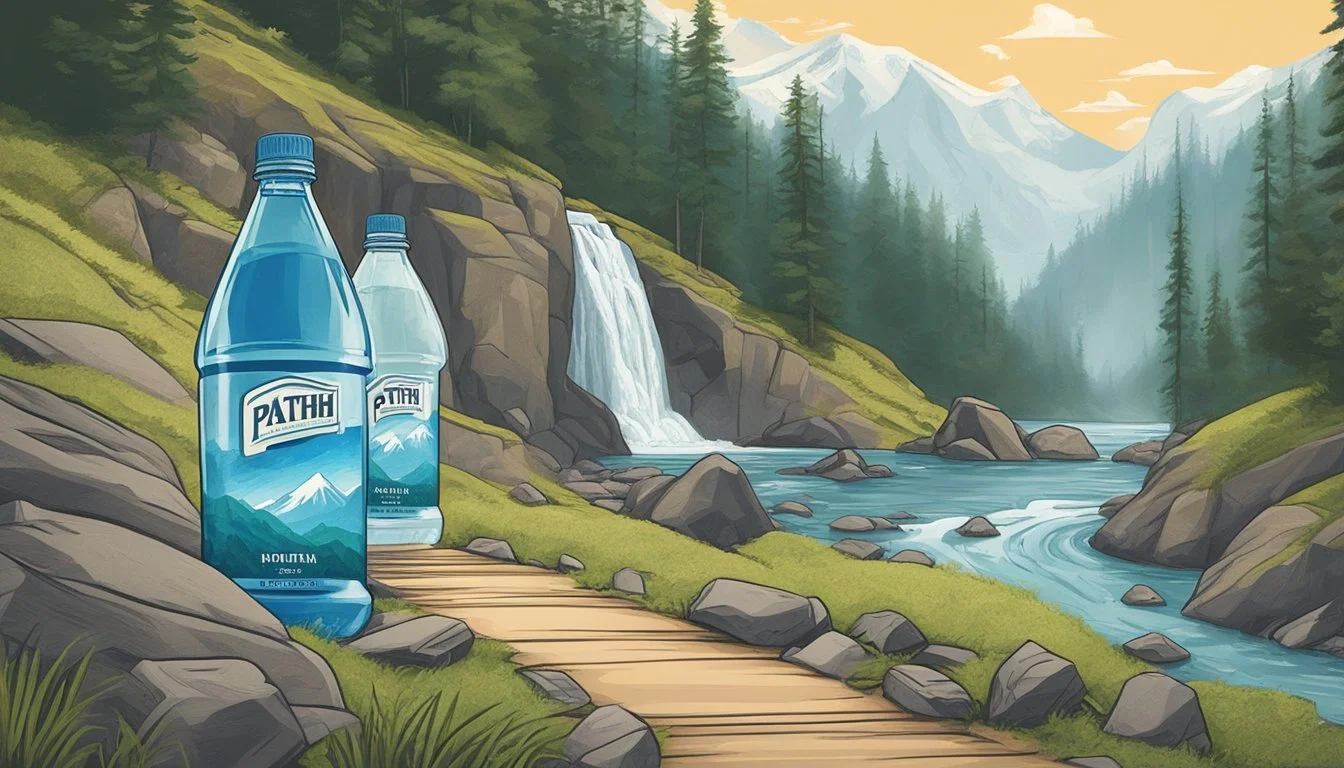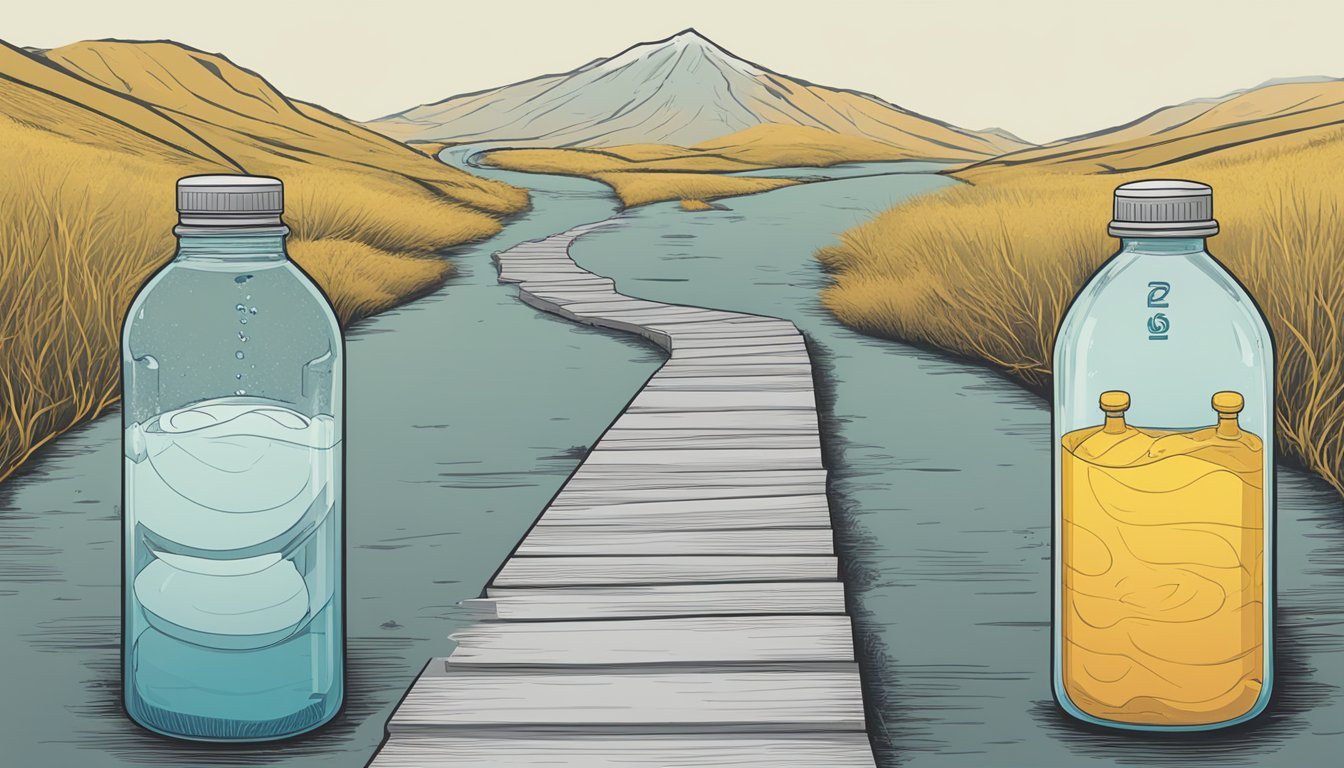Path vs. Liquid Death
Comparing Bottled Water Brands
Choosing the right bottled water can be a crucial decision for many, whether it's about taste, health benefits, or environmental impact. Path and Liquid Death are two popular brands, each offering unique attributes. When comparing these brands, Path's focus on sustainability with reusable aluminum bottles stands in stark contrast to Liquid Death's edgy marketing and convenient single-use cans.
Path offers still water sourced from natural springs, emphasizing purity and eco-conscious packaging. On the other hand, Liquid Death provides both sparkling and still options with an emphasis on intense branding and flavor variations like Mango Chainsaw. Each brand aims to attract different segments of environmentally aware consumers.
When it comes to accessibility and assortment, Liquid Death's distribution through major retailers like Whole Foods and 7-11 makes it easily available, whereas Path's niche market might appeal more to those prioritizing sustainable living. For eco-friendly consumers, Path's reusable bottles are a clear winner, whereas Liquid Death's variety and bold flavors might appeal more to those looking for a unique twist in their hydration experience.
Understanding Bottled Water
Bottled water plays a significant role in the global beverage market with options ranging from still to sparkling and from various sources like mountains or tap water.
The Rise of Bottled Water
The bottled water industry has seen rapid growth over the past few decades. Factors contributing to this trend include concerns over tap water quality and the convenience of pre-packaged hydration solutions.
Early adoption was driven by the perception of bottled water being cleaner and more health-conscious. Marketing efforts further capitalized on this by associating products with pristine sources, such as mountain springs.
Modern consumers often prefer bottled water not only for its perceived safety but for the portability and accessibility it offers in a busy lifestyle.
Types of Bottled Water
There are several categories of bottled water, each catering to different preferences and needs. Still water remains the most common, offering a taste and texture similar to tap water but often sourced from springs or purified through advanced filtration.
Sparkling water, on the other hand, includes additional carbon dioxide for a fizzy texture, providing a refreshing alternative to soft drinks. Brands such as Liquid Death capitalize on unique packaging and branding to stand out in this space.
Other varieties include mineral water, which contains minerals from the source, and spring water, often marketed for its natural purity. Each type offers distinct benefits, whether it's taste, added health benefits, or simply the allure of luxury.
Examining Liquid Death
Liquid Death is a distinctive bottled water brand known for its bold marketing and eco-friendly packaging. This section explores the brand's unique identity, characteristics of its products, and environmental contributions.
Brand Overview
Founded by Mike Cessario, Liquid Death emerged as a game-changer in the bottled water industry. The brand's motto, "Murder Your Thirst," showcases its edgy marketing approach. They appeal primarily to younger consumers with a rebellious and humorous brand image. By using canned water instead of plastic bottles, they aim to make environmentally responsible choices more appealing.
Product Characteristics
Liquid Death offers both still and sparkling waters, sourced from the Austrian Alps. The water is packaged in recyclable aluminum cans. The sparkling variant is carbonated, providing a refreshing taste. No additives are present in the water, making it a pure option for hydration. The natural flavors in the sparkling version add a unique twist compared to traditional bottled water.
Environmental Impact
The choice of aluminum cans over plastic bottles is a significant eco-friendly move. Aluminum is infinitely recyclable and requires less energy to recycle compared to plastic. This makes Liquid Death a more sustainable option, as the environmental footprint is lower. Additionally, recycling one aluminum can save enough energy to power a television for three hours, emphasizing the environmental benefits of choosing this brand.
Exploring Path Water
Path Water emphasizes sustainability with its reusable aluminum bottles, unique branding, and eco-conscious initiatives, making it a notable contender in the bottled water market.
Brand Essence
Path Water's brand revolves around environmental responsibility. They position themselves as a sustainable alternative in a market saturated with single-use plastic bottles. The company’s mission is combating plastic pollution through innovative packaging solutions. By focusing on reusable and infinitely recyclable aluminum bottles, Path Water underscores its commitment to reducing plastic waste and promoting responsible consumption.
Product Features
Path Water offers its product in sleek, reusable aluminum bottles that stand out on shelves. The bottles are designed not only for their aesthetic appeal but also for their durability. Customers can refill these bottles multiple times, reducing the need for single-use plastics.
Key features include:
100% Reusable and Recyclable Bottles: Made from aluminum, which can be recycled indefinitely.
Variety: Available in still and sparkling options.
Convenience: The durable bottles are perfect for on-the-go lifestyles.
The focus on longevity and sustainability in product design supports the brand's mission.
Eco-Conscious Initiatives
Path Water’s commitment to the environment extends beyond its products. Their initiatives include educational campaigns about plastic pollution and partnerships with environmental organizations.
Notable initiatives:
Plastic Pollution Awareness: Path Water actively educates consumers on the impact of plastic waste.
Collaborations: They partner with like-minded organizations to promote environmental sustainability.
Refill Programs: Encouraging consumers to refill their bottles rather than discard them.
These efforts are geared towards fostering a culture that values sustainability and responsible consumption. Path Water’s holistic approach aims to create a significant positive impact on the environment.
Market Presence and Accessibility
Both Liquid Death and Path have notable market presence and accessibility, yet they achieve it through different channels and strategies.
Retail and Online Availability
Liquid Death has a strong retail footprint, with its products available in 60,000 stores across the United States. Major retailers such as Whole Foods and Target stock Liquid Death, making it convenient for consumers to find. Additionally, Liquid Death is one of the top-selling drinking waters on Amazon, which increases its reach to customers opting for online shopping.
Path Water also enjoys extensive retail and online availability. Path can be found in many leading retailers, including Whole Foods, and it has a robust presence on Amazon. Its eco-friendly image appeals to a wide consumer base, facilitating distribution through numerous health and environmentally conscious retail outlets.
Popularity and Consumer Reach
Liquid Death leverages viral marketing to boost its popularity. The brand’s unique and edgy personality resonates on social media platforms like Instagram and TikTok, attracting a younger demographic. Such campaigns increase consumer curiosity and enhance its reach.
Path Water promotes sustainability and an eco-friendly ethos, which has made it popular among environmentally conscious consumers. Complementing its retail presence, Path engages customers through effective social media campaigns and partnerships with influencers who emphasize sustainability. This focus appeals to a niche but growing segment of the market, driving its popularity further.
Packaging and Sustainability
Liquid Death and Path differ significantly in their packaging strategies and commitment to sustainability. These differences are key considerations when choosing a bottled water that aligns with eco-friendly values.
Material Analysis
Liquid Death uses recyclable aluminum cans for its packaging. Aluminum is advantageous as it is infinitely recyclable, requiring less energy to recycle compared to producing new plastic. This choice stands in sharp contrast to traditional plastic bottles, which are common in the bottled water industry but less eco-friendly.
Path opts for reusable aluminum bottles. These bottles are designed to be refilled, reducing single-use plastic waste. Additionally, Path’s bottles often come with stainless steel caps for durability.
Both choices highlight a clear move away from conventional plastic bottles, promoting more sustainable materials like aluminum and stainless steel.
Sustainability and Recycling Efforts
Liquid Death's commitment to sustainability is evident in their use of recyclable aluminum. The aluminum cans not only support recycling efforts but also encourage consumers to be more conscious about the materials they use. This approach significantly lessens the environmental impact compared to single-use plastic bottles.
Path emphasizes reusability. By offering products that can be repeatedly refilled, they significantly cut down on waste. Stainless steel caps and sturdy design promote long-term use, which is a strong sustainable feature of their packaging.
Both brands aim for eco-friendly solutions, but their methods — recycling vs. reusability — cater to different aspects of sustainability, offering consumers eco-conscious choices.
Consumer Perception and Brand Image
Liquid Death and Path foster distinct consumer perceptions through their unique branding and targeted marketing approaches.
Marketing Strategies
Liquid Death, founded by Mike Cessario, utilizes an unconventional, punk-rock inspired branding with a provocative tagline: "Murder your thirst!" Their marketing approach includes striking aluminum cans and edgy, irreverent campaigns. They leverage social media, particularly Instagram, to connect with a younger audience. Partnering with notable figures like Travis Barker for endorsements, they create a rebellious and appealing brand image.
Path takes a different route, focusing on sustainability. The brand emphasizes its reusable aluminum bottles, positioning itself as an eco-friendly choice. Their marketing campaigns highlight environmental responsibility and long-term impact, appealing to conscious consumers. Path's strategies are less aggressive but target a niche group that values sustainability over novelty.
Cultural and Media Resonance
Liquid Death's bold marketing has gained attention from major media outlets like The New Yorker and NBC News, solidifying its place in popular culture. Their quirky attitude and engaging content have become conversation starters, making the brand a cultural phenomenon. The heavy social media presence, with viral content, contributes to its wide recognition and strong cultural resonance.
Path, while quieter in its approach, garners respect for its commitment to sustainability. It attracts media coverage for its positive environmental impact and innovative packaging. Though it doesn’t have the same viral media traction as Liquid Death, Path resonates deeply with eco-conscious communities. Their message of sustainability appeals broadly but resonates most with those prioritizing environmental impact.
Comparative Analysis
When comparing Path and Liquid Death bottled water, key considerations include taste and quality, value and cost efficiency, and health and nutritional factors. Each brand offers distinct features that appeal to different consumer preferences.
Taste and Quality
Path and Liquid Death differ significantly in taste and quality. Liquid Death offers both still and sparkling options with high carbonation levels, providing a refreshing and fizzy experience. The sparkling varieties come in natural flavors, enhancing the drinking experience without added sugars or artificial ingredients.
Path focuses on pure, smooth-tasting water. The brand sources its water from natural springs, ensuring a clean, crisp taste. Users often find Path’s still water to be an excellent choice for daily hydration, with no notable aftertaste.
Value and Cost Efficiency
Value and cost efficiency vary between the two brands. Liquid Death is available at several retailers, including Target and Whole Foods, with prices averaging around $1.62 per can. The brand's unique branding and packaging contribute to its premium price point.
Path water typically sells in bulk, which can be more cost-efficient for regular consumers. The durable, reusable aluminum bottles add to its value, promoting sustainability and reducing single-use plastic waste. Path's competitive pricing makes it a practical option for many.
Health and Nutritional Factors
From a health perspective, both Path and Liquid Death provide beneficial hydration options. Liquid Death’s sparkling water includes carbonation, which can aid in digestive health for some individuals. The flavored variants do not contain added sugars or artificial ingredients, making them a healthier alternative to sugary drinks.
Path water boasts naturally occurring electrolytes, supporting better hydration and energy replenishment. The absence of added ingredients ensures it remains a pure and healthy choice. Additionally, Path’s commitment to sustainable packaging aligns with broader health and environmental goals.
Final Conclusion
When comparing Path and Liquid Death, several factors come into consideration: packaging, taste, and cost.
Packaging: Path uses reusable aluminum bottles, positioning itself as an eco-conscious brand. Liquid Death also uses aluminum but focuses on single-use cans.
Taste: Liquid Death offers both flat and sparkling water. Path typically offers still water with a clean, neutral taste.
Cost: Liquid Death tends to be more budget-friendly per ounce compared to Smart Water, for instance. Path, with its premium branding, often commands a higher price point.
In summary, whether Path or Liquid Death is the better bottled water depends on individual preferences regarding sustainability, taste, and cost. Both brands provide unique advantages, aligning with different consumer values and needs.
More About Path
Mountain Valley Spring Water vs Path: Which Bottled Water is Better?
Path vs Whole Foods Italian Still Mineral water: Which Bottled Water is Better?
More About Liquid Death
Aqua Carpatica vs Liquid Death: Which Bottled Water is Better?
Core Hydration vs Liquid Death: Which Bottled Water is Better?
Hawaii Volcanic vs Liquid Death: Which Bottled Water is Better?
Hawaiian Springs vs Liquid Death: Which Bottled Water is Better?
Ice Mountain vs Liquid Death: Which Bottled Water is Better?
Icelandic Glacial vs Liquid Death: Which Bottled Water is Better?
Liquid Death vs Cascade Mountain: Which Bottled Water is Better?
Liquid Death vs Crystal Geyser: Which Bottled Water is Better?
Liquid Death vs Crystal Lake: Which Bottled Water is Better?
Liquid Death vs Essence pH10: Which Bottled Water is Better?
Liquid Death vs Kirkland Signature: Which Bottled Water is Better?
Liquid Death vs Proud Source: Which Bottled Water is Better?
Liquid Death vs Richard's Rainwater: Which Bottled Water is Better?
Liquid Death vs Simple Truth: Which Bottled Water is Better?
Liquid Death vs Talking Rain AQA: Which Bottled Water is Better?
Liquid Death vs Whole Foods 365: Which Bottled Water is Better?
Liquid Death vs Whole Foods Italian Still Mineral water: Which Bottled Water is Better?
Mountain Valley Spring Water vs Liquid Death: Which Bottled Water is Better?
Nestle Pure Life vs Liquid Death: Which Bottled Water is Better?
Poland Spring vs Liquid Death: Which Bottled Water is Better?
Purely Sedona vs Liquid Death: Which Bottled Water is Better?
San Pellegrino vs Liquid Death: Which Bottled Water is Better?
Solan de Cabras vs Liquid Death: Which Bottled Water is Better?







